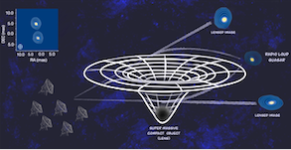SMILE: Searching for MIlli-LEnses to discriminate between dark matter models

One of the most compelling mysteries in both cosmology and particle physics is the nature of Dark Matter (DM). We investigate this problem using strong gravitational lensing of active galaxies on the key but poorly-explored milli-arcsecond scales, i.e. Milli-lenses. Gravitational lensed images with angular separation on milliarcsecond scales probe gravitational lens systems where the lens is a supermassive compact object, i.e a compact object with mass in the range 106 to 109 solar masses. Compact objects in this mass range could be i) sub-galactic DM halos (in the surroundings of galactic DM halos or in the field), ii) primordial black holes, also considered an alternative candidate to DM particles, (iii) supermassive black holes hosted by galaxies.
The most direct way to explore these small angular scales is through the high-resolution of radio Very Long Baseline Interferometry (VLBI). We will search for milli-lenses using VLBI data of a complete and large (~ 5000 sources) sample of radio loud active galaxies, in order to constraint the abundance of supermassive compact objects in the universe. Such a constraint will help discriminating between different DM models that predict different numbers and density profiles for DM halos at sub-galactic scales.
The SMILE project is led by Dr. Carolina Casadio and supported by the European Research Council.
